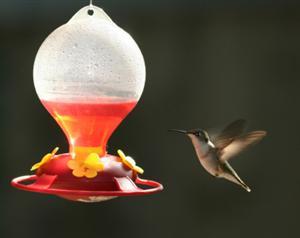| Complexity level: | 6 |
| Project cost ($): | 20 |
| Time required: | It will take 3 days to prepare for this science project, and 5 days to conduct it |
| Material availability: | Easily found at a pet store |
| Safety concerns: | None |
Hypothesis
Of all the feeders, the birds will most prefer eating from the red feeder.
Overview
What colors are birds attracted to?
We will never know whether birds see or recognize colors in the same way that humans do. Still, we can make an educated guess. Male birds tend to have beautiful, colorful feathers, making them attractive to female birds. Based on this observation, there is good reason to believe that birds are able to perceive colors.
A bird’s eye makes up almost 15% of its body’s weight. In comparison, the human eye makes up only about 1% of our body’s weight. A bird’s eye has cones. Researchers who have examined these cones assert that there is a diverse range of colored oil droplets and visual pigments in these cones, and that his means that birds have a very highly developed sense of color recognition. Some species, such as the hummingbird, are believed to be able to see ultraviolet light because the flowers from which they drink the nectar have patterns that are visible only under the ultraviolet light.
To find out what colors birds are attracted to, we can look at the colors of flowers and fruits birds tend to consume. Humming birds, for example, like the color red. Other species such as the oriole like orange; they tend to feed on orange nectar.
Scientific Terms
Materials
The materials required for the experiment are as follows:
- 5 bird feeders
- 5 cans of spray paint that come in different colors (red, orange, blue, green and white)
- a pack of sunflower seeds
Procedure
1. For this experiment, the independent variable is the color of 5 bird feeders (red, orange, blue, green and white). The dependent variable is the number of birds that visit each feeder. This is determined by observing and counting how many birds visit each feeder. The constants (control variables) are the amount of time allocated as feeding time, the type of bird food used, and the size of the bird feeders.
2. Paint the 5 bird feeders red, orange, blue, green and white using the spray paint. Let them dry for 2 days.
3. On the third day, the paint should have dried completely. Arrange the bird feeders such that they are each 3m apart from one another.
4. Feed the birds only once a day, in the morning between 8:00 am and 10:00 am. Fill the trays in the feeders with sunflower seeds. Count how many birds feed at each feeder and record this in the table below.
5. Over the next 4 days, randomly change the position of the bird feeders. Are the birds still attracted to the same feeders? Does the color or location of the feeders play a bigger role? Repeat procedure number 4. Ensure that the birds are fed only once a day, and feeding should occur at the same time each morning.

Results
Of all the feeders, the birds were most attracted to the red one. This was followed by the orange feeder.
| Days | Number of birds that visit the bird feeders | ||||
| Red | Orange | Blue | Green | White | |
| 1 | 5 | 3 | 0 | 2 | 2 |
| 2 | 8 | 6 | 1 | 1 | 0 |
| 3 | 12 | 8 | 1 | 1 | 1 |
| 4 | 15 | 9 | 0 | 2 | 2 |
| 5 | 17 | 10 | 2 | 2 | 2 |
| Total | 57 | 36 | 4 | 8 | 7 |
Use the graph below to plot your results

Conclusion
The hypothesis holds true: of all the feeders, the birds enjoyed eating from the red feeder the most.
Bird watching is a common hobby. For young watchers, bird watching is both educational and entertaining. Bird watching can also leads to other interests such as nature trekking and photography. Having a bird sanctuary or feeder at home is a good idea. On top of the above advantages of bird watching, birds help with pest control: they eat insects in your garden.
Also consider
Use different types of feed such as worms, corn and berries, to further test whether birds actually have a preference for the color of the feeder. For example, if you ascertain that the birds prefer a particular type of feed over another, and yet, when placed in the red feeder, the less popular type of feed attracts more birds, that will help corroborate your findings.
What colors are particular species of birds attracted to? .
References
Colors that attract birds - http://www.birdfeedersblog.com/birds/882-colors-that-attract-birds/
How to attract birds - http://bird-watching.suite101.com/article.cfm/how_to_attract_birds
Do birds see color? - http://www.birdnote.org/birdnote-transcript.cfm?id=174

